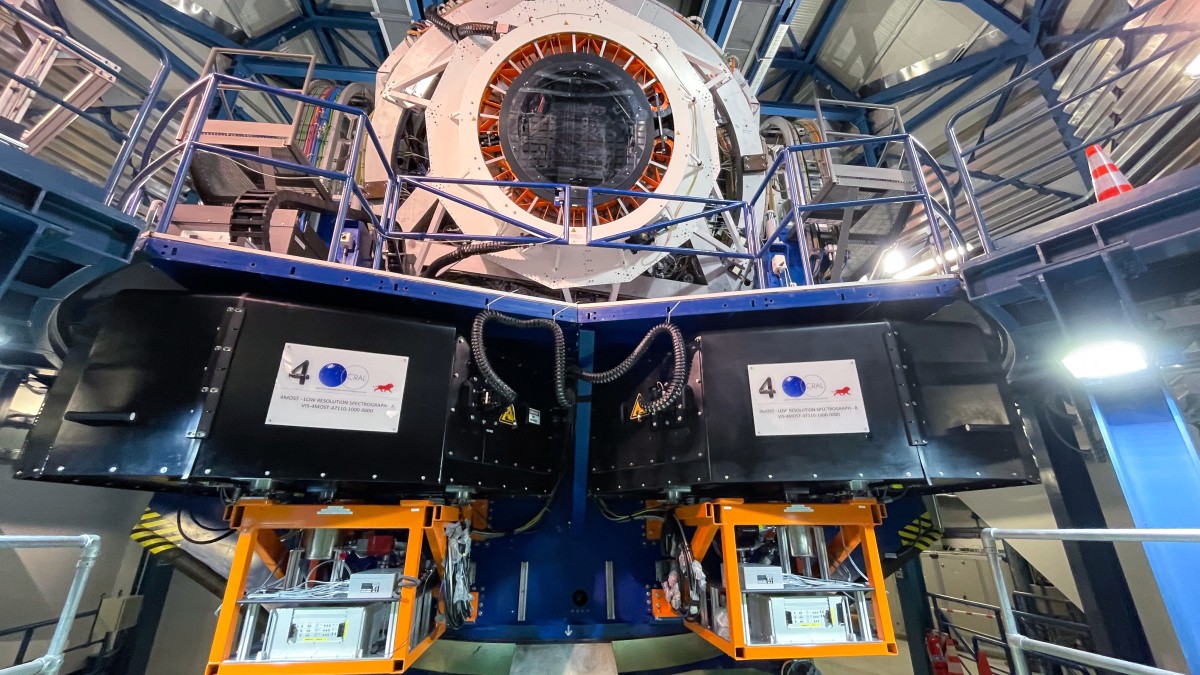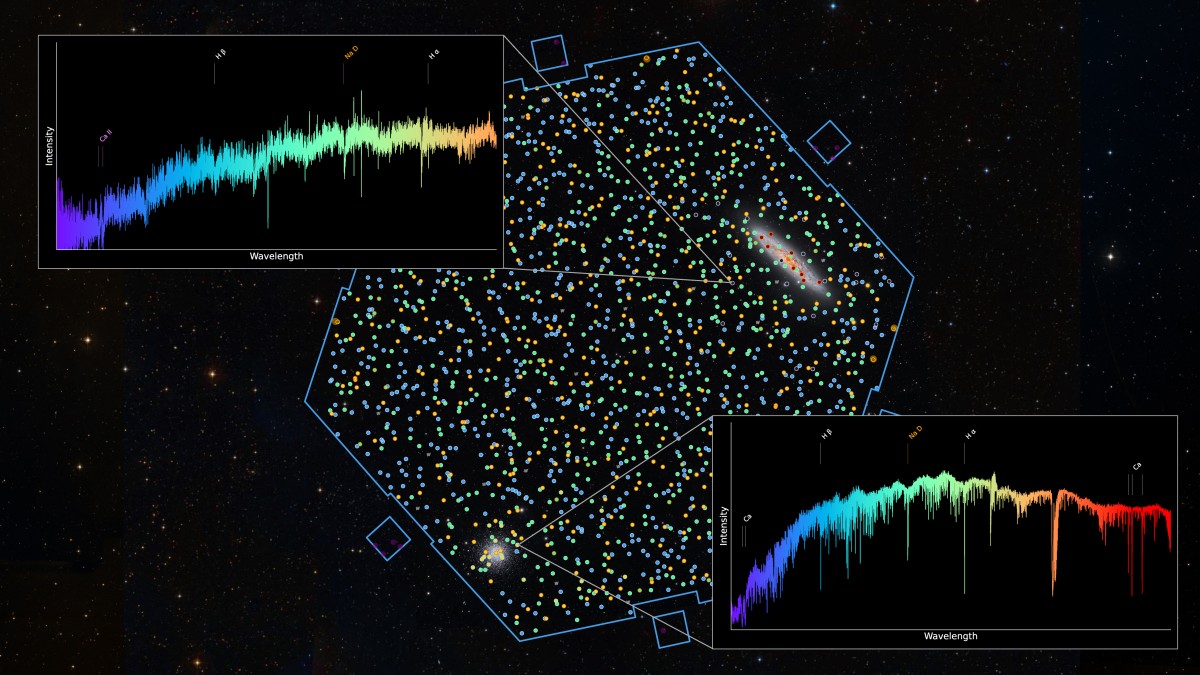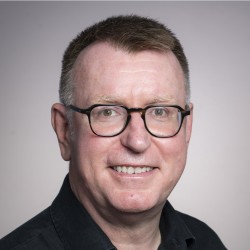Surrey astronomers help deliver first light data from new 4MOST telescope
A new telescope designed to study everything from exploding stars to the expansion of the Universe has captured its first light – with University of Surrey researchers playing a key role in bringing the facility into full operation.

The 4-metre Multi-Object Spectroscopic Telescope (4MOST) is ready for observations. At the top is the telescope itself, below (black boxes) are two of the three spectrographs that break down starlight into thousands of colour components.
The 4-metre Multi-Object Spectroscopic Telescope (4MOST) facility, installed on the VISTA telescope at the European Southern Observatory’s (ESO) Paranal Observatory in Chile, recorded its first data on 18 October, 2025. This milestone is a crucial step in the life of any telescope, marking the moment it is ready to begin its scientific journey.
4MOST breaks down the light of up to 2,400 objects simultaneously into 18,000 colour components, allowing astronomers to probe their detailed chemical composition and properties. Once fully operational, it will investigate the formation and evolution processes of stars and planets, the Milky Way and other galaxies, black holes and other exotic objects and the Universe as a whole.

The sky around the Sculptor Galaxy NGC 253 and the globular cluster NGC 288 was the target of the first observations with 4MOST. The blue frame shows the boundary of 4MOST's field of view. Each circle symbolises one of the more than 2400 fibres. The embedded images show the spectrum of a star (right) and the spectrum of a globular cluster in the Sculptor Galaxy (left).
Analysing the detailed rainbow-like colours of thousands of objects every 10–20 minutes, 4MOST will build a catalogue of temperatures, chemical compositions, velocities and many more physical parameters of tens of millions of objects spread across the entire Southern sky. Its exceptionally wide field of view, covering an area five times the size of the full Moon, will allow scientists to observe vast regions of the sky far more efficiently than ever before.
The telescope’s first observations highlight its powerful capabilities, capturing the nearby Sculptor Galaxy (NGC 253) – a stellar nursery bursting with new stars – and the ancient globular cluster NGC 288, home to around 100,000 stars formed more than 13 billion years ago. 4MOST’s sensitive spectrographs also revealed a pair of galaxies 900 million lightyears away and over 1,000 other galaxies up to 10 billion lightyears distant, offering a glimpse of the kind of data that will help astronomers understand how the Universe formed and evolved.
The University of Surrey’s involvement with 4MOST stretches back to its earliest stages. Professor Bob Nichol, a professor of Astrophysics and Pro-Vice-Chancellor and Executive Dean of the Faculty of Engineering and Physical Sciences at Surrey, was the founding scientist of the Time-Domain Extragalactic Survey (TiDES) – a dynamic constituent of 4MOST designed to capitalise on another revolutionary new telescope, the US National Science Foundation/Department of Energy-led Vera C. Rubin Observatory.
Every time 4MOST observes, TiDES will use a handful of its fibres to observe recently discovered “transient” objects discovered in Rubin’s Legacy Survey of Space and Time (LSST). The 4MOST observations of tens of thousands of exploding stars (supernovae) and other exotic and dramatic phenomena like the shredding of stars by supermassive black holes will be the largest such programme dedicated to Rubin. Using 4MOST classifications and other information available in the Rubin data, TiDES will transform our understanding of how stars evolve and die and contribute to the most precise measurements of the effects of dark energy on cosmic expansion and the fundamental make up of our Universe.
TiDES will also make high-precision measurements of the masses of almost 1000 active supermassive black holes, and 10,000 strongly gravitationally lensed galaxies. By building the largest catalogue of black hole masses, TiDES will provide an independent standard candle alongside supernovae. This will transform our understanding of how galaxies and black holes grow together and deliver powerful new constraints on the nature of dark energy and the expansion of the Universe.
The University of Surrey’s contribution also involves training the next generation of astronomers. Harry Addison, a PhD student in Surrey’s Astrophysics Research Group, is part of the commissioning team preparing 4MOST for full science operations.
Designed to operate for at least the next 15 years, 4MOST is the largest multi-object spectroscopic survey facility in the southern hemisphere. Run by an international team of 30 research institutions, it will deliver insights into the origins of stars and galaxies, the nature of dark matter and dark energy and the fundamental forces that govern our Universe – with Surrey expertise helping to make that possible.
###
Notes to editors
- Professor Bob Nichol and Harry Addison are available for interview; please contact mediarelations@surrey.ac.uk to arrange.
- Find out more about 4MOST here: https://www.aip.de/en/news/4most-first-light/
- Image 1: The 4-metre Multi-Object Spectroscopic Telescope (4MOST) is ready for observations. At the top is the telescope itself, below (black boxes) are two of the three spectrographs that break down starlight into thousands of colour components. Credit: AIP/A. Saviauk
- Image 2: The sky around the Sculptor Galaxy NGC 253 and the globular cluster NGC 288 was the target of the first observations with 4MOST. The blue frame shows the boundary of 4MOST's field of view. Each circle symbolises one of the more than 2400 fibres. The embedded images show the spectrum of a star (right) and the spectrum of a globular cluster in the Sculptor Galaxy (left). Credit: AIP/R. de Jong, Centre de Recherche Astrophysique de Lyon/J.-K. Krogager, Background: Harshwardhan Pathak/Telescope Live
- Image 3: The "First Light" field of view with targets of the 4MOST fibres shown as coloured circles. Credit: AIP/R. de Jong, Background: Harshwardhan Pathak/Telescope Live
Featured Academics
Media Contacts
External Communications and PR team
Phone: +44 (0)1483 684380 / 688914 / 684378
Email: mediarelations@surrey.ac.uk
Out of hours: +44 (0)7773 479911

